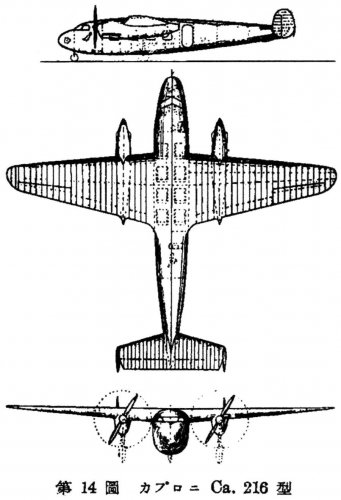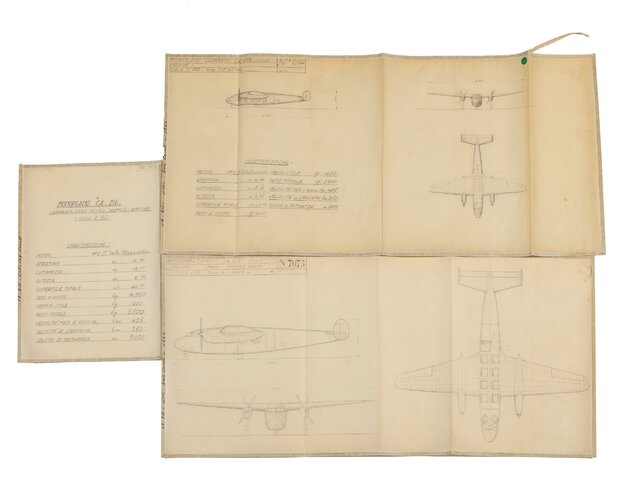- Joined
- 25 July 2007
- Messages
- 4,299
- Reaction score
- 4,198
Caproni Ca.216
While refreshing the Caproni designation lists, I came across my first mention of a Caproni Ca.216. At first, I assumed this to be a wartime Japanese publication but Google Translate revealed to be from Japan Aviation Magazine of a date I can't be sure of. [1] The Ca.216 entry is on page 780. At any rate, the original source is listed as Interavia 734, 1940/11/5, 5/6 (presumably meaning pages 5 and 6).
A tiny 3-view drawing of the Ca.216 is reproduced, showing an airliner with a superficially-similar appearance to the de Havilland DH.95 Flamingo ... but rather smaller and powered by Isotta-Fraschini Delta R.C.35-IS V-12 engines. Compared with the the DH.95, the Caproni design was more than 1,000 kg lighter but carried only 8 passengers and a crew of 2 (vs. 17 passengers and a crew of 3 for the de Havilland airliner). That makes the Caproni seem a bit heavy but it was of wooden construction while the DH.95 was metal. In any case, with its limited seating, the Caproni Ca.216 is probably best described as a feederliner.
A set of specifications is given for the Ca.216 (a cleaned-up Google Translate version of which is reproduced below). For comparison, DH.95 dimensions were: Span 21.34 m; wing area 60.50 m², and length 15.73 m. DH.95 weights were: Empty 5,137 kg, Loaded 7,983 kg, Payload 2,846 kg. However, with its 930 hp Bristol Perseus XVI radials, the de Havilland airliner had 460 additional horsepower at its disposal. Another major difference was that the DH.95 was a more conventional tail-dragger whereas the Ca.216 was to have a retractable tricycle undercarriage.
As to accuracy, other Caproni aircraft are shown in the same section - the Ca.311 and Ca.602. Both descriptions are attributed to Interavia with a quite accurate 5-view drawing of the Ca.311 and two photos of the Ca.602 shown. Not definitive by any means, but it suggests that the Interavia description of the Ca.216 project might also be accurate.
So the questions are:
- Does anyone have any more on this Ca.216 (or other Caproni Taliedo Ca.2xx civilian projects)?
- Are any Japanese-speaking forum members willing to check the machine-translation from this pdf?
- Do any forum members have access to the original article in Interavia 734?
____________________________
Google Translate
Japan Aviation Magazine July 1st, 2004 8th 75th
(7511) Caproni Ca.216
Type - small transport aircraft; shoulder-mounted cantilever-winged land-based aircraft; crew 3, passenger 8; wooden structure; tricycle wheel retractable undercarriage; Isotta · Fraskini "Delta" (Isotta-Fraschini "Delta") R.C. 351. S-type [ie: R.C.35-IS] air-cooled inverted V-12 (with machine gun) [2] engines (Take-off output: 700 horsepower at 2,400 r.p.m., Normal output: 700 horsepower at 3,500 m at 2,400 r.p.m., Maximum output: 750 horsepower at 2,600 r.p.m.) x 2; two-blade variable-pitch propeller. (Kitagawa) [3]
[? ?] Wingpan 16.9 m, overall length 15.1 m, overall height 3.3 m, wing area 40.0 m², Weight 4,100 kg, Load 1,600 kg, Total Weight 5,700 kg, wing load 142.0 kg/mm², horsepower load 2.27 kg/wing, wing 37.5 horsepower/mm².
[Performance] Maximum Speed (at 4,000 m) 418km/h, Cruising Speed 350km/h, Service Ceiling 9,000 m.
[Source] Interavia 734: 1940/11/5; 5/6.
____________________________
[1] The date 01 July 2004 is given twice ... but this might be the creation date of the pdf. There is also a garbled "8th 75th" which could mean Vol.8, No.75 or perhaps refer to an August 1975 edition.
[2] The "(with machine gun)" on the Delta engine may be an artifact of machine translation ... although the Ca.311 is correctly noted to be machine gun-armed. So, there's a chance that the Ca.216 was meant to be both a feederline and a Coloniale utility transport aircraft.
[3] I'm not sure what the parenthetical "Kitagawa" refers to. It is a family name, of course, so may just credit a magazine contributor. Contempory references could be to then-Col. Kiyomi Kitagawa of the Army Aviation School ... but that would require this entry to be a reprint of information compiled for the IJAAF c.1940.
While refreshing the Caproni designation lists, I came across my first mention of a Caproni Ca.216. At first, I assumed this to be a wartime Japanese publication but Google Translate revealed to be from Japan Aviation Magazine of a date I can't be sure of. [1] The Ca.216 entry is on page 780. At any rate, the original source is listed as Interavia 734, 1940/11/5, 5/6 (presumably meaning pages 5 and 6).
A tiny 3-view drawing of the Ca.216 is reproduced, showing an airliner with a superficially-similar appearance to the de Havilland DH.95 Flamingo ... but rather smaller and powered by Isotta-Fraschini Delta R.C.35-IS V-12 engines. Compared with the the DH.95, the Caproni design was more than 1,000 kg lighter but carried only 8 passengers and a crew of 2 (vs. 17 passengers and a crew of 3 for the de Havilland airliner). That makes the Caproni seem a bit heavy but it was of wooden construction while the DH.95 was metal. In any case, with its limited seating, the Caproni Ca.216 is probably best described as a feederliner.
A set of specifications is given for the Ca.216 (a cleaned-up Google Translate version of which is reproduced below). For comparison, DH.95 dimensions were: Span 21.34 m; wing area 60.50 m², and length 15.73 m. DH.95 weights were: Empty 5,137 kg, Loaded 7,983 kg, Payload 2,846 kg. However, with its 930 hp Bristol Perseus XVI radials, the de Havilland airliner had 460 additional horsepower at its disposal. Another major difference was that the DH.95 was a more conventional tail-dragger whereas the Ca.216 was to have a retractable tricycle undercarriage.
As to accuracy, other Caproni aircraft are shown in the same section - the Ca.311 and Ca.602. Both descriptions are attributed to Interavia with a quite accurate 5-view drawing of the Ca.311 and two photos of the Ca.602 shown. Not definitive by any means, but it suggests that the Interavia description of the Ca.216 project might also be accurate.
So the questions are:
- Does anyone have any more on this Ca.216 (or other Caproni Taliedo Ca.2xx civilian projects)?
- Are any Japanese-speaking forum members willing to check the machine-translation from this pdf?
- Do any forum members have access to the original article in Interavia 734?
____________________________
Google Translate
Japan Aviation Magazine July 1st, 2004 8th 75th
(7511) Caproni Ca.216
Type - small transport aircraft; shoulder-mounted cantilever-winged land-based aircraft; crew 3, passenger 8; wooden structure; tricycle wheel retractable undercarriage; Isotta · Fraskini "Delta" (Isotta-Fraschini "Delta") R.C. 351. S-type [ie: R.C.35-IS] air-cooled inverted V-12 (with machine gun) [2] engines (Take-off output: 700 horsepower at 2,400 r.p.m., Normal output: 700 horsepower at 3,500 m at 2,400 r.p.m., Maximum output: 750 horsepower at 2,600 r.p.m.) x 2; two-blade variable-pitch propeller. (Kitagawa) [3]
[? ?] Wingpan 16.9 m, overall length 15.1 m, overall height 3.3 m, wing area 40.0 m², Weight 4,100 kg, Load 1,600 kg, Total Weight 5,700 kg, wing load 142.0 kg/mm², horsepower load 2.27 kg/wing, wing 37.5 horsepower/mm².
[Performance] Maximum Speed (at 4,000 m) 418km/h, Cruising Speed 350km/h, Service Ceiling 9,000 m.
[Source] Interavia 734: 1940/11/5; 5/6.
____________________________
[1] The date 01 July 2004 is given twice ... but this might be the creation date of the pdf. There is also a garbled "8th 75th" which could mean Vol.8, No.75 or perhaps refer to an August 1975 edition.
[2] The "(with machine gun)" on the Delta engine may be an artifact of machine translation ... although the Ca.311 is correctly noted to be machine gun-armed. So, there's a chance that the Ca.216 was meant to be both a feederline and a Coloniale utility transport aircraft.
[3] I'm not sure what the parenthetical "Kitagawa" refers to. It is a family name, of course, so may just credit a magazine contributor. Contempory references could be to then-Col. Kiyomi Kitagawa of the Army Aviation School ... but that would require this entry to be a reprint of information compiled for the IJAAF c.1940.
Attachments
Last edited by a moderator:


